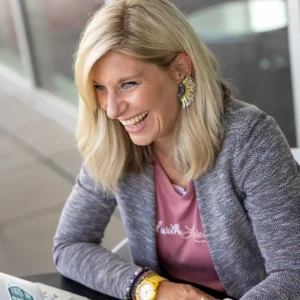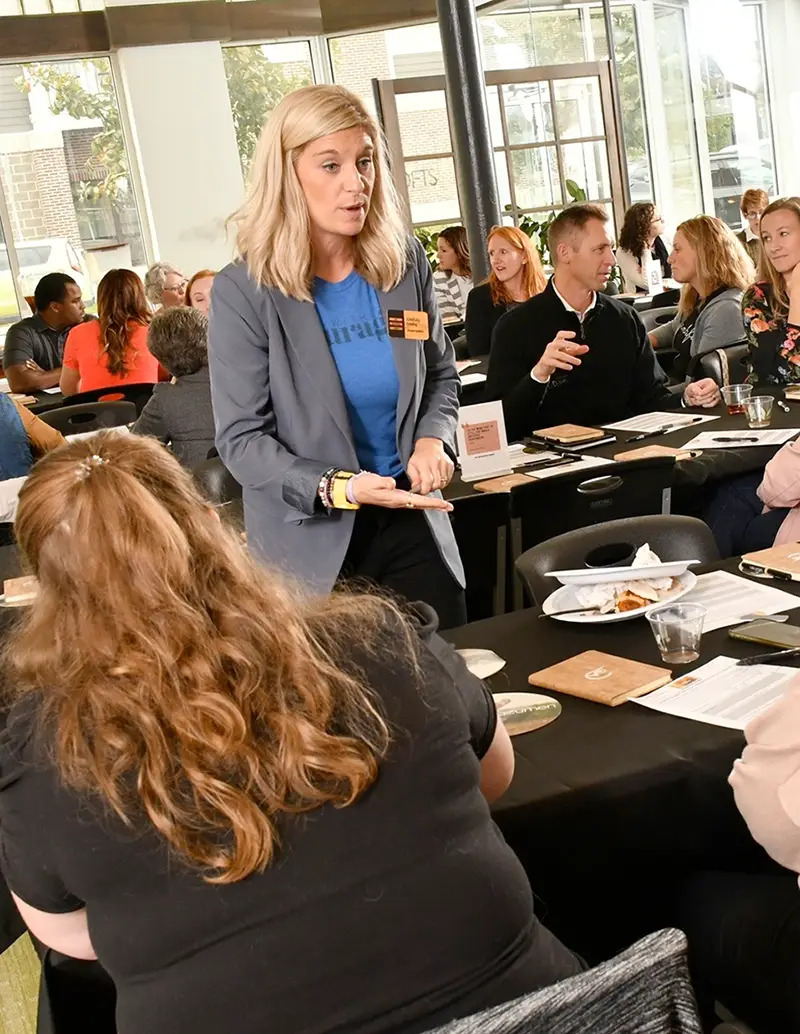What is enough? When will I do enough? When will I be enough?
Every one of us wrestles with these questions. The danger is that we seek our validation from external sources instead of finding those answers within us for ourselves. If you haven’t already, go back and read Part 1 of this blog post which walks us through the importance of our first step in finding our way back to enough – (Re)Building Connection.
Then read Part 2 which explores Restoring Intention. The goal of step 2 is to become mindful of and present to what we want. Once we have completed those steps we can move into step 3 which is Taking Inspired Action. This step empowers us to act on purpose and with meaning. We know we are taking inspired action when we allow our heart to lead us, we experience peace in our decisions, and we confidently accept and navigate things as they come.
Even when we have rebuilt connection and restored our intention, it can be difficult to take inspired action. We let our fear of what others might think or how they might react hold us back. It can be easier to say “yes” instead of saying “no” or respond to requests for our time and energy rather than putting the priorities we feel called to first. In this step we can defy our intuition, find ourself making excuses or blaming others, and playing the victim. Fear and resentment are key indicators that we are not taking inspired action. Taking inspired action is a requirement in finding our way back to enough.
I recently found myself in a situation where I had made a commitment to an organization that I wasn’t sure I wanted to fulfill. I had been an active participant and advocate for a few years, but in the last year or so the dynamics had changed and the intentions and vision that the majority of the group had were different from my own. I felt myself dreading meetings, and often left meetings feeling out of my integrity. The old me would have just kept my head down and mouth shut out of a sense of duty and responsibility. I would have stuffed those feelings of dread and being out of my integrity. But this time I decided to do something different, and work toward taking inspired action.
I addressed my feelings with other people in the group, I shared my vision and intentions for the organization and as I spoke up it became clear that we were not in alignment and there wasn’t much room for discussion with the majority. I was facing a dilemma. Do I stick it out because I committed? Do I say in it because I think they need me? Do I push through my feelings and this current situation and hope for the best?
I gave myself time and space to think and pray about it. What was revealed to me was to be clear about my non-negotiables (what I needed to stay in my integrity) and ask for an open discussion. I did that and it was made clear there was no room for discussion and no intention to consider my non-negotiables. Although my ego wanted to stay in “the fight” and “win,” I ultimately felt called to “drop the rope” and walk away.
The few days and weeks after this decision, I felt a lot of guilt and sadness, but also a deep and profound relief. A knowing that I made the right decision. I felt liberated even though people were upset with me and things didn’t turn out like I had hoped. It wasn’t 100% clear or straightforward, but deep down I knew I had taken inspired action.
Let me share some exercises and questions that can help you gain clarity to take inspired action in your own life and work. The first is an exercise I use all the time: when I’m feeling overwhelmed, when I have a big decision to make, when all the thinking and walking and writing just aren’t helping. This exercise helps us sort through all the complexity of what’s going on in our mind and heart so we can separate things and see them more clearly. It’s called the Dumping Exercise.
The Dumping Exercise (An exercise to help us take inspired action)
This is a simple exercise that is intended to show you where you’re giving your power away, to put your priorities in black and white, and help you consider: What’s reasonable and realistic? What do I want/need to stop doing?
Get out a sheet of paper, lay it landscape and draw three columns. At the top of the first column write: What’s on my to do list? At the top of the second column write: What’s on my mind? At the top of the third column write: What’s on my heart?
We start with the to do list because it’s usually front of mind and the easiest to get out. For those of us that get easily overwhelmed by our list, this is a good practice to use everyday. Getting it on paper relieves the mental stress of carrying it around. Then we can check it off or put it in our calendar and know it will get done.
We move from the to do list to what’s on our mind. What are you thinking about? What are you worried about? Don’t overthink it, just write down whatever comes to mind and keep writing until there is nothing left to write down. (You will be more open and things will flow more easily the more you practice).
Next close with what is on your heart. How are you feeling? What emotions are you carrying? Again, don’t overthink, just write. Many of us have a hard time naming how we feel. This is perfectly normal because we haven’t been taught much in the realm of emotional intelligence or feelings. This chart displays from the inside some of the basic emotions, to more nuanced as you move out. Take a look if that’s helpful!
Now, you should have a list of to dos + things on your mind and heart. The next step is to look at that list and first consider what you need to delete. What is not yours to carry? There will typically be things in the “what’s on your mind” and “what’s on your heart” column that you cannot control and/or are not yours to carry. Be honest with yourself here. So much of our energy gets zapped trying to control things we can’t, and taking on other people’s issues. Delete anything that is not yours so you can find your way back to enough and take inspired action.
Next, look at the list for things you can delegate. These will most often come from your to do list. Most of us are not good at delegating because we like control. Be honest about what you really need to do…or better yet, mark everything delegate that someone else could do and keep on the list the things only you can do.
Finally, take the rest of the list and prioritize it. You will have to dos to address, and you can think about how you will take action on some of the things on your mind and heart list to move them off. Sometimes that requires simply letting something go, having a conversation, or taking another action of some kind.
As you can see, using this exercise helps you get your priorities down in black and white, and be intentional in how you move forward. This is the work that allows you to take inspired action. This is the work that helps you find confidence and clarity that you are doing enough and that you are enough.
Once you get a little more practiced in becoming aware of what’s on your heart, mind and to do list, you can more easily align priorities and take inspired action by revisiting the following list of reflection questions:
Questions to help us take inspired action include:
- What do I need to let go of?
- What do I need more of?
- How can I best contribute?
- What is my heart telling me?
These questions help us come back to our heart and our needs, clarify where we feel like we need to focus, and proceed accordingly. In our daily lives, we can get swept up into fulfilling the requests and desires of everyone else which ultimately leads us away from inspired action and makes us feel like we aren’t doing enough. We have a list of things we want to get done, feel called to and believe are important but we are putting that aside for everyone else. The requests can build up so high that we aren’t doing anything well, so then we are not only letting ourselves down but others as well.
As you can see, this can quickly lead us to a place where we feel like we aren’t enough. It’s up to us to take back control of our commitments and how we use our time and energy, so that we can be confident we are contributing in a meaningful way and that we are aligned to our priorities.
Practices to help us take inspired action
Taking inspired action requires that we are consistently centered and grounded. Things will happen to us. Things will change. Unexpected roadblocks will pop up. We have an opportunity to take ownership of how we respond. We can take a pause, and allow more space between stimulus (what happens) and response (how we react), so we are taking inspired action. To come back to a place of centered and groundedness before we proceed. The following practices can help us do that:
Setting and keeping boundaries
We can’t be everywhere all the time, and we can’t be everything to everyone. Each of us has to decide what we will give and what we need to protect. I would suggest considering the boundaries you put around your time, energy, emotions, noise and relationships to start. Let’s explore boundaries around time. What are the sacred times of day and the important activities you want to protect?
Here are some ideas from me. While on one hand, I have a little more flexibility as a business owner in my scheduling, I also own the responsibility to fill hours and use my time very intentionally because if I don’t see clients, I don’t get paid. Some things working for me include: I don’t take a first appointment of the day until 8am so that I have 5-7:30am to myself for my workout, prayer, meditation, Bible time and other parts of my morning routine. This helps me start the day well and center myself in who I want to be and how I want to show up.
I leave 4:30-5 open each day to have time to wrap up and be home and transitioned into my evening by 5:30. I block follow up, project and admin time on my calendar. I limit myself to 3 coaching clients per day so I have enough energy to provide a quality experience. I tackle the most difficult projects and to dos early in the day when my energy is high.
My husband and I proactively sit down every quarter or so to schedule fun and personal activities so they don’t become after thoughts, and so we can be intentional about who we spend time with and how we invest that time. I schedule in creative days off for just me. I schedule in rest time and self-care activities and I don’t allow things to override them. If I don’t take care of myself, I can’t take care of anyone else.
I proactively think through and schedule out some learning and development activities for the year, and keep a running list of books I want to read and podcasts I want to listen to. I also put my phone on do not disturb at 8pm and plan to be in bed by 9:30.
I find a lot of freedom within these boundaries on my time. I have learned what works and what’s best for me, so if I stick to it, I can stay centered and grounded. I have less decisions to make and can put more energy into my relationships and being present. Those are just a few tips around time from my own life to help you consider your own time boundaries.
Building habits
Another great way to take inspired action is by building habits. Some of the greatest leaders wear the same thing each day and eat the same thing at the same time each day. Many also choose to get up and go to bed at the same time each day and have morning and evening routines, including exercise, they stick to no matter what. These habits free up our mental and emotional capacity. Habits allow us to operate without thinking. If I’m not worried about what I will wear or what I will eat, I am free to think about other things.
This might seem extreme to some, and for others you might feel constricted by this idea. You have to figure out what works for you. I couldn’t eat the same thing everyday, but I do prioritize healthy eating, so in our house we go to the store on the weekend and I meal prep for the week on Saturday or Sunday depending on our schedule. This means we have healthy options to grab or heat up and I don’t have to worry about what’s for dinner.
Categories to consider building habits into include: Sleep, Healthy Eating, Exercise, Intention Setting, Think Time, Preparation time, Morning and Evening Routine, Learning, Vision and Goal Setting, Rest, Self-Care, Getting Outside
Atomic Habits: Tiny Changes, Remarkable Results is an excellent book written on habits. One of my key takeaways from the book is the important role our mindset plays in adopting a new habit successfully, and how critical it is to have a vision tied to your commitment. For example, for most people it’s not enough just to commit to exercising once per day to stick to it. Those who consider what the positive results of this will be in the long-term (what the vision for the future looks and feels like), and who align themselves at an identity level to the goal (I am an active person and/or what would an active person do), are much more successful in following through and creating successful habits.
Systems to support taking inspired action
A final thing to offer here are systems to help us take inspired action. As the pace of change increases and the number of demands and distractions grow, these systems become more and more important in helping us take inspired action.
We already talked through The Dumping Exercise, so here are a few other framework/routines/systems to consider that help us stay centered and grounded so we can take inspired action:
- Letting Go: Make time in your day to consider what you are holding onto: mentally, emotionally, physically and let it go. You can do this through breathing, journaling, visualizing a release, discussing with a friend, etc. There is so much that comes at and to us each day, it’s important we have a system to regularly let go of what isn’t ours so it doesn’t build up over time.
- Filling Up: Make a list of the things that make you feel good. Walking outside, talking with a friend, reading the Bible, listening to music, sitting in silence, etc. Create ways to sprinkle those activities into your day, and when you are feeling depleted, make space and time to get filled up.
- Gratitude: This is a simple practice that can have a profound impact on your life! I like to incorporate gratitude at the beginning and end of each day – saying what I am thankful for before my feet hit the floor. This sets my heart and mind on a positive trajectory. At the end of each day I like to reflect on 3 things I’m grateful for in that day as away to recenter and reground my heart and mind.
- SNAP + Practicing the Pause: We addressed SNAP (stop + notice + ask + pivot) in a previous post and talked about the power of the pause in this one. Create a system by which you give yourself the chance to make space between stimulus and response so you can respond intentionally vs. react. This may mean more space between meetings, taking breaks in the day, taking a breath before talking in response to someone, etc.
- Reflect + Regroup: We all start the year, quarter, month, week and even day with a set of intentions and goals…and then life happens. We need regular space to reflect, regroup and re-evaluate. Whether you are revisiting your personal goals or an organizational plan, having this space at least monthly is critical to taking inspired action. You can use questions like: what’s working? what’s not working? what am I learning? what’s changed? what hasn’t changed? what is most important now? and other questions to help you reflect and regroup.
You only get one life and you have a unique call. My hope is that this series equips you with questions, concepts, tools and practices that will help you build connection, restore intention, and take inspired action so you can find your way back to enough and fulfill your unique call with your amazing gifts and talents in a wholehearted way!
Still struggling with finding your way to enough and could use support? Email me at dreambuilder@the-restorationproject.com to discuss additional resources and services that can support you on your journey!

Written by: Lindsay Leahy, Dream Builder at The Restoration Project


